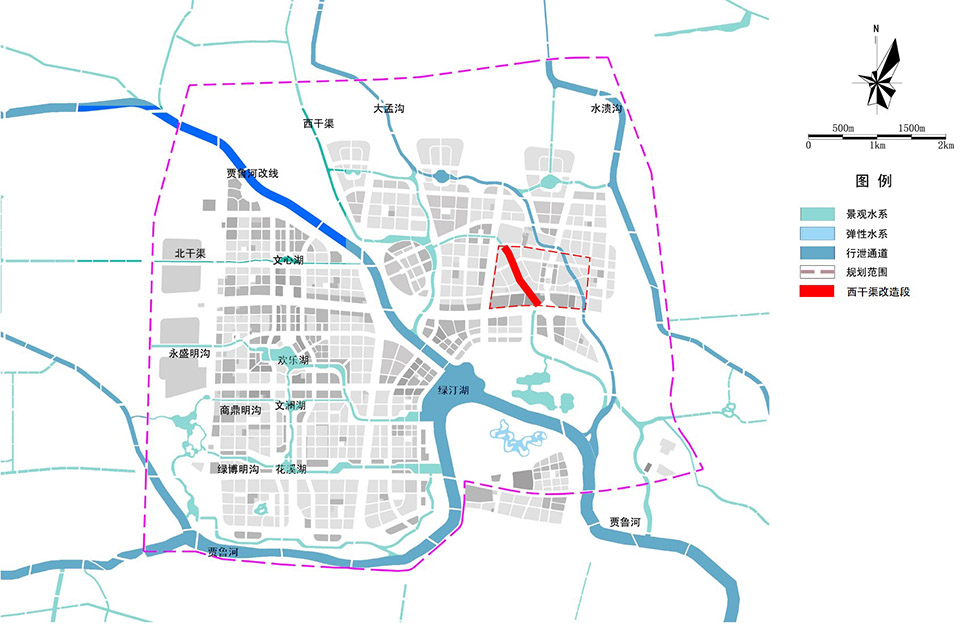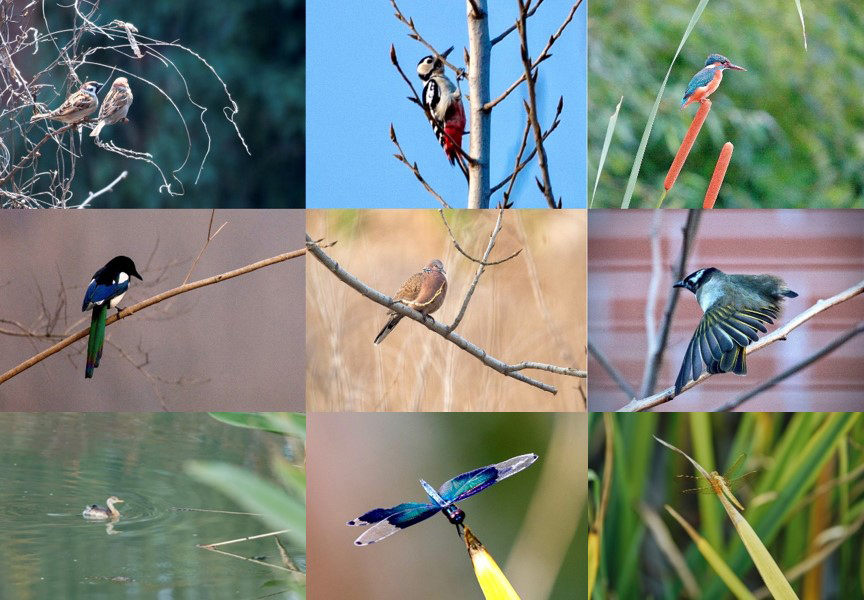01.設(shè)計(jì)源起
Origin of design
西川原名“西干渠”,全段31公里,北起黃河南岸,往南最終流入鄭州牟山濕地公園,是一條農(nóng)田灌溉渠道。
Xichuan, an agricultural irrigation canal known as ‘Xigan Canal’ before, stretches for 31 kilometers from the south bank of the Yellow River to Moushan Wetland Park in Zhengzhou.

▲項(xiàng)目區(qū)位圖,Project location map ? 翰祥景觀
近十年來,隨著鄭州國際產(chǎn)業(yè)園區(qū)的建設(shè),水系規(guī)劃被提上日程,結(jié)合鄭州市中牟縣雁鳴湖片區(qū)的陸續(xù)開發(fā)規(guī)劃,西干渠所扮演的角色發(fā)生轉(zhuǎn)換,在滿足灌溉功能的同時(shí),也被要求創(chuàng)造出能供市民娛樂休閑的活力空間,促進(jìn)人與自然的融合。結(jié)合區(qū)域總體規(guī)劃,我們負(fù)責(zé)進(jìn)行改造設(shè)計(jì)的“西川”,位于鄭州市中牟縣大孟鎮(zhèn),信王節(jié)制閘至逐鹿?fàn)I之間,總長約2.1公里。這段改造段被定義為中牟縣水系改造的示范段落,它的建成將為區(qū)域性水系改造,尤其是灌溉渠道改造,提供指引方向。
In nearly a decade, the city water system planning is on the agenda with the construction of Zhengzhou industrial park. The role of Xigan Canal has changed to better combining with the on-going development planning of the Yanming Lake area, Zhongmou County, Zhengzhou. Therefore, Xigan Canal is asked to both meet the requirement of irrigation function and create a recreation space for public entertainment and leisure, which can ultimately promote the fusion of nature and humankind.Considering about the overall planning, Xichuan, restored and designed under our charge, is located between Xinwang check gate and Zhulu camp in Dameng Town, Zhongmou County, Zhengzhou. The reconstruction section with a total length of about 2.1 kilometers is defined as the demonstration section of water system reconstruction in Zhongmou County. Its completion will provide guidance for the improvement of regional water systems, especially irrigation channels.

▲鄭州國際文化創(chuàng)意產(chǎn)業(yè)園分區(qū)水系規(guī)劃(2015-2030年),西干渠全段都被定義為景觀水系,需要承擔(dān)城市觀景與濱水休閑功能Water system planning for Zhengzhou International Cultural and Creative Industry Park (2015-2030). Xigan Canal is defined as landscape water system which functioned both as urban landscape and waterfront leisure ? 翰祥景觀
2.場(chǎng)地現(xiàn)狀
Site description
大孟鎮(zhèn)屬北溫帶大陸性季風(fēng)氣候,冷暖適中、四季分明,春季干旱少雨,夏季炎熱多雨,秋季晴朗日照長,冬季寒冷少雪。全年平均氣溫14.2℃,平均降雨量616 毫米。境內(nèi)有大小河流124條,分屬于黃河和淮河兩大水系。西干渠屬黃河水系,水源為黃河灌溉引水,水量較少;渠道寬度約6米,深度約1.5米,基底為全硬質(zhì)混凝土結(jié)構(gòu)以提升灌溉效能。改造段周邊農(nóng)田已大部分荒廢,地勢(shì)平坦,水體表面漂浮大量的農(nóng)業(yè)生活垃圾、枯枝雜草等。渠道基本不具備水生態(tài)系統(tǒng),自身凈化能力較弱,水體總體呈富營養(yǎng)化趨勢(shì)。
Dameng Town belongs to the north temperate continental monsoon climate with mean annual temperature of 14.2 ℃ and mean annual precipitation of 616 mm. It has moderate temperature and distinct seasons with dry spring, hot rainy summer, sunny autumn and cold winter with little snow. There are total 124 rivers in this area which belong to Yellow River and Huai River. Xigan Canal belongs to Yellow River water system, which water source is the irrigation and diversion of the Yellow River with a small water yield. The canal is about 6 meters wide and 1.5 meters deep, and its base is made of all-hard concrete structure for the aim of improving irrigation efficiency. The farmland around the reconstruction area is flat and has been largely abandoned, resulted in a massive number of agricultural household garbage, weeds and twigs floating on the surface of water. Hence, due to its weak purification capacity and generally eutrophic water body, the canal basically cannot function as a water ecosystem.
3.設(shè)計(jì)策略:從“西干渠”到“西川”
Design strategy: from ‘Xigan Canal’ to ‘Xichuan’
隨著城市擴(kuò)張與更新速度加快,很多農(nóng)耕土地在開發(fā)進(jìn)程中被荒廢,大量的人工干預(yù)與開發(fā)影響了整個(gè)生態(tài)環(huán)境系統(tǒng),原生動(dòng)植物所剩無幾,生物棲息環(huán)境變得惡劣。西干渠就是一個(gè)典型案例。
西干渠改造項(xiàng)目,旨在修復(fù)渠道及其周邊的藍(lán)帶生態(tài)系統(tǒng),恢復(fù)河流水生態(tài)環(huán)境的連續(xù)性和完整性,凈化水體,把生物多樣性、棲息地營造納入城市發(fā)展的重要環(huán)節(jié),重新構(gòu)建人和自然、河流的聯(lián)結(jié),為城市帶來活力和場(chǎng)所歸屬感。將臟亂破敗的灌溉用“西干渠”,重生為對(duì)城市、環(huán)境及居民聯(lián)結(jié),不可或缺的“西川”。
設(shè)計(jì)之初,我們首先對(duì)西干渠上中下游水質(zhì)進(jìn)行了取樣分析,水質(zhì)報(bào)告顯示,渠道內(nèi)水質(zhì)問題主要是有機(jī)物污染和氮磷等營養(yǎng)物質(zhì)含量較高,會(huì)引起藻類迅速繁殖,造成水體持續(xù)惡化,失去自凈功能。水體的污染治理與生態(tài)系統(tǒng)重建也因此成為項(xiàng)目的最大挑戰(zhàn)。基于設(shè)計(jì)目標(biāo)與項(xiàng)目現(xiàn)況,我們制定了如下設(shè)計(jì)策略,分步解決西干渠的各項(xiàng)問題:
1.進(jìn)行污染源研究,從源頭了解并解決水質(zhì)污染問題,構(gòu)建生態(tài)水系統(tǒng),讓水體具備自身凈化能力
2.同步構(gòu)建西干渠延邊生態(tài)環(huán)境,創(chuàng)造藍(lán)綠帶過渡空間與濕地空間,豐富區(qū)域性動(dòng)植物物種,讓整體生態(tài)循環(huán)體系形成閉環(huán),實(shí)現(xiàn)永續(xù)發(fā)展目標(biāo)
3.在此基礎(chǔ)上,重建河岸空間功能,利用設(shè)計(jì)引導(dǎo)居民使用,讓居住生活與河道生態(tài)系統(tǒng)和諧共處,最終實(shí)現(xiàn)設(shè)計(jì)愿景
With the acceleration of urban expansion and renewal, a lot of agricultural land has been abandoned in the process of development. A large number of artificial intervention and exploitation have affected the whole ecological environment system, with fewer and fewer native plants and animals left, and the environment of habitat becoming worse and worse. Xigan Canal is a typical case in this way.
The Xigan Canal reconstruction project aims to restore the blue belt ecosystem of the canal and its surrounding areas, and rebuild the continuity and integrity of the river water ecological system. More importantly, this project can help purify the water body and bring the construction of habitat environment into the essential process of city development, which would reconstruct the link between nature and humankind and create vitality and sense of belonging for the city. Last but not the least, transforming the ‘Xigan Canal’, a dirty and dilapidated irrigation canal, into a clean and indispensable ‘Xichuan’ would be an important, new bond to connect city, environment and residents.
At the beginning of the design, we sampled the water quality of the upstream, midstream and downstream of Xigan Canal. The water quality report shows that the water quality problem in the canal is mainly due to organic pollution and the high content of nutrients such as nitrogen and phosphorus, which will lead to the rapid propagation of algae and the continuous deterioration of the water, and importantly, the loss of self-purification function. Therefore, regulation of water pollution and reconstruction of ecosystem have become the biggest challenge of this project. Based on the design objectives and the existing situation, we formulated the following design strategies and try to solve the problems of Xigan Canal step by step:
1. Research on the pollution source of Xigan Canal, understand and solve the water pollution problem, rebuild the water ecosystem and make the water self-purifying.
2. Construct the ecological environment at the surrounding area of Xigan Canal and create the transition space of blue and green belt and wetland space synchronously. Enrich regional animal and plant species, make the whole ecological cycle system form a closed loop, and finally achieve the goal of sustainable development.
3. On this basis, we are trying to rebuild the spatial function of the river bank and guide the residents to enjoy and use it through the design, and make the living life and the river ecosystem co-exist harmoniously, and finally realize the design vision.
4.污染源研究
Research of pollution sources
經(jīng)過多次實(shí)地調(diào)研,并與相關(guān)專家的討論研究,我們發(fā)現(xiàn)西干渠改造段水質(zhì)污染,主要由以下兩個(gè)方面造成:
After plenty of field investigations and discussions with relevant experts, we found that the two main causes of water pollution in the reconstruction area of Xigan Canal are as follows:
一、渠道內(nèi)部污染源
The internal pollution source of canal
1)上游來水污染
渠道上游水流已經(jīng)帶來較多農(nóng)業(yè)、建筑及生活垃圾,含枯枝樹葉、塑料制品、農(nóng)業(yè)廢棄物等,這些垃圾沿途與渠中水草和藻類形成絮狀物,加劇水體富營養(yǎng)化和藻類爆發(fā)。
2)漂浮物污染
渠道內(nèi)的漂浮污染物,包括樹枝落葉、腐爛水生植物和生活垃圾等,它們互相作用共同形成了類似腐殖質(zhì)的產(chǎn)物,一方面會(huì)影響渠道水面景觀,另一方面也會(huì)增加渠道內(nèi)有機(jī)物的含量,同時(shí)增加水體污染負(fù)荷,導(dǎo)致水質(zhì)不斷惡化。
3)底泥污染
渠道內(nèi)厭氧污泥以及腐殖質(zhì)的不斷形成與沉積,使水體污染物濃度增加,底泥微生物降解有機(jī)污染物過程會(huì)消耗水中的溶解氧,同時(shí)底泥懸浮過程中吸附的污染物還會(huì)向水體擴(kuò)散、釋放,成為二次污染,這些影響讓水體溶解氧持續(xù)減少、形成黑水、臭水,造成了水體富營養(yǎng)化的惡性循環(huán)。
1 )Upstream water pollution
The upstream water of canal has brought plenty of garbage from agriculture, construction and household including dry branches and leaves, plastic things and wasted farming products, which combined the aquatic plants and algae along the way in the canal into flocculation and thus exacerbating the outbreak of water eutrophication and algal bloom.
2) Floatation pollution
Pollutants floating in the canal, including decaying aquatic plants and household garbage, interact with each other and gradually form into humus-like products. This would not only affect the water surface landscape of the canal, but also increase the organic matter content in the canal and aggravate water pollution, result in the continuous deterioration of water quality.
3) Sediment pollution
The continuous formation and deposition of anaerobic sludge and humus in the canal would increase the concentration of water pollutants. The microbial degradation of organic pollutants in the bottom sediments would consume the dissolved oxygen in the water. At the same time, the adsorbed pollutants in the suspension process of the bottom sediments would diffuse and release to the surrounding water, causing secondary pollution. These impacts would continuously reduce the dissolved oxygen in the water and form black and foul water, resulting in a vicious cycle of water eutrophication in the canal.

▲改造前河道現(xiàn)狀:上游來水、渠道漂浮物及底泥污染為其內(nèi)部污染原因 The situation of canal before reconstruction: upstream pollution, floating pollution and sediment pollution are the main cause of internal pollution. ? 翰祥景觀
二、渠道外部污染源
The external pollution source of canal
1)生活污水
生活污水呈現(xiàn)有機(jī)物和氮磷濃度高的特點(diǎn),其中黑水(包括糞尿和廁所沖洗水)和灰水(包括洗浴、洗衣和廚房廢水)在水質(zhì)和水量上也有很大差異,部分生活污水還含有重金屬和有毒有害物質(zhì),水質(zhì)波動(dòng)較大,進(jìn)入渠道后增加水體自凈功能負(fù)荷,易引起渠道水體富營養(yǎng)化,是渠道重要外部污染源。
2)生活垃圾
渠道周邊村民的生活垃圾,餐飲固體垃圾以及建筑施工過程中的廢棄物等會(huì)不同程度的排入到渠道中污染水體;垃圾堆放過程中產(chǎn)生的大量酸性和堿性有機(jī)污染物,包括部分重金屬溶解,會(huì)經(jīng)由雨水沖入渠道污染水體。
3) 面源性污染
農(nóng)業(yè)生產(chǎn)活動(dòng)中施用的化肥、農(nóng)藥和營養(yǎng)鹽元素等未經(jīng)作物利用的,以及道路、綠化產(chǎn)生的地表徑流污水等,這些污染物在降水、灌溉或排放過程中,通過地表徑流、排水和地下淋溶等形式,進(jìn)入水體而形成面源污染。它們將危害到水體的自然生態(tài)功能,使地表水富營養(yǎng)化及地下水的硝酸鹽含量超標(biāo),影響水資源的可持續(xù)利用。
1) Sanitary sewage
Sanitary sewage showed high concentration of nitrogen, phosphorus and organic matters, in which ‘black water’ (including fecal urine and toilet flushing water) and ‘grey water’ (e.g. bath, laundry and kitchen wasted water) are largely different from each other in water quality and quantity. Some sanitary sewage also contains heavy metals and toxic, harmful substances which leads to great fluctuation in water quality. The self-purification function would be overloaded when sanitary sewage entering into the canal. Sanitary sewage is an important external pollution source of canal which can easily cause water eutrophication.
2) Household waste
The household garbage of the villagers around the canal, solid food garbage and the waste in the construction process would be discharged into the canal and pollute the water body to different degrees. Meanwhile, during the garbage stacking process, a large number of acidic and alkaline organic pollutants including dissolution of some heavy metals, could be washed into the canal by raindrops and thus polluting the water.
3) Non-point pollution
Non-point pollution includes plant-unutilized fertilizers, pesticides and nutrients applied in agricultural production process, and surface runoff of sewage generated by road greening etc. These pollutants would enter the water through surface runoff, drainage and underground leaching in the process of precipitation, irrigation and discharging, thus forming into non-point pollution. They would harm the natural ecological function of the water body, make surface water eutrophication and nitrate content of groundwater exceeding the standard, and finally affect the sustainable use of water resources.

▲改造前河道現(xiàn)狀:生活污水、生活垃圾及面源性污染為其外部污染原因 The situation of canal before reconstruction: Sanitary sewage, household waste and non-point pollution are the main cause of external pollution. ? 翰祥景觀
5.生態(tài)水凈化系統(tǒng)
Ecological water purify system
基于污染源研究成果,我們發(fā)現(xiàn)在西干渠改造段中,無法解決上流水源的生活污水、面源性污染等問題,改造段的水體生態(tài)凈化措施尤為重要。因此,改造的第一個(gè)工作重點(diǎn),落在水質(zhì)凈化系統(tǒng)設(shè)計(jì)上,我們希望建立足夠生態(tài)的凈化系統(tǒng),幫助河流建立并逐步提高自身凈化能力,構(gòu)建健康的自凈循環(huán),盡可能減少人工干預(yù),實(shí)現(xiàn)永續(xù)目的。
措施一:以生態(tài)手法,對(duì)上流水源進(jìn)行沉淀、過濾等凈化處理
在上游水源流入之前,我們就對(duì)其進(jìn)行凈化處理,上游入水口采用生物攔截隔離生活垃圾等較大懸浮物,設(shè)置沉砂池去除懸浮顆粒,再透過物生物凈化、表流濕地、水下森林組合凈化方式優(yōu)化水質(zhì)后,才能流入西干渠改造段。
措施二:全流域架構(gòu)水下森林與表流濕地,培養(yǎng)水體自凈能力
以能耐寒越冬的苦草為主要植被,在水底大面積種植,提供微生物生長的附著空間,與睡蓮、菖蒲、鳶尾等等挺水植物一同,構(gòu)建出水下森林,增加水體氧氣含量。在施工完成的1.5公里河道內(nèi),已創(chuàng)建了接近20處大小不一的濕地水體,能供生物棲息,營造人與自然和諧相處的環(huán)境。
Based on the results of our pollution sources research, we found that the problem of sanitary sewage and non-point pollution of upstream could not be solved in the reconstruction process of Xigan Canal. It is particularly important to purify the water ecologically in the reconstruction area. Therefore, the first key emphasis in our reconstruction work is to design a water purification system. We hope to establish an adequate ecological purification system and help the canal develop and gradually improve its own purification capacity, furthermore building a healthy self-purification cycle and minimizing artificial intervention, and finally achieving sustainable goals.
Step 1: Purify the upstream water by ecological means, such as sedimentation, filtration etc.
We choose to purify the upstream water before it comes into the canal. The upstream inlet adopts biological interception to isolate large suspended solids such as domestic garbage, and sets sand sink to remove suspended particles. Only after the water quality is optimized by the combined purification method of ‘microbial purification微生物凈化’, ‘surface runoff wetland purification表流濕地’ and ‘underwater forest purification水下森林’ can it flow into the reconstruction section of Xigan Canal.
Step 2: Build ‘underwater forest purification’ and ‘surface runoff wetland purification’ through the whole basin and develop self-purify capacity of the canal.
In order to provide the attachment space for microbial growth, we are trying to plant a large area of Vallisneria spiralis underwater, which is the main vegetation and can endure cold and survive through winter. Together with the planting of emergent aquatic plant such as Nymphaea alba, Acorus calamus, Iris tectorum etc., ‘ underwater forest perification’ would be built and help increase the content of oxygen in water. We have created nearly 20 wetlands with different sizes within the 1.5 km canal that reconstruction completed, which would provide habitats for living creatures and create a harmonious environment between nature and human.

▲西川的生態(tài)水凈化系統(tǒng),The ecological water purify system of ‘Xichuan’ ? 翰祥景觀


▲經(jīng)過生態(tài)凈化的西川水清澈潔凈,達(dá)國家三類水標(biāo)準(zhǔn) The Xichuan water becomes clear and clean which meets the national three-class water standard after ecological purification ? 琢墨攝影
措施三:河床去硬質(zhì)化,恢復(fù)河道自然形態(tài)
為了通過生態(tài)手法解決渠道內(nèi)部的底泥污染及漂浮物污染問題,提升水體自身凈化能力,我們打破了渠道原有結(jié)構(gòu),恢復(fù)自然蜿蜒的河流形態(tài)。去硬質(zhì)化的河床橫截面擴(kuò)大(由原來的6米拓展到10-15米),減緩的流速讓微生物、水生動(dòng)物能夠在此安家。改造混凝土駁岸,以石籠、壘石、杉木樁等生態(tài)工法創(chuàng)造多孔性的駁岸結(jié)構(gòu),為兩棲動(dòng)物和產(chǎn)卵魚類提供更為平緩的水域與棲息環(huán)境。至此,西干渠改造段重生成為“西川”。
Step 3: Restore the natural shape of river band by removing the artificial, hard riverbed.
On the other hand, in order to solve sediment pollution and floatation pollution and improve the self-purify capacity of the canal through ecological methods, we broke the original structure of the canal and restored the canal morphology of natural meandering river form. We removed the artificial, hard riverbed and expanded the cross-section of the riverbed (from 6 meters to 10-15 meters), in order to slow the flow rate and allow aquatic animals and microbes to make home there. Moreover, we created porous structure using ecological methods such as stone cage石籠, piled stone壘石 and cedar piles杉木樁 to reform the concrete revetment, which would provide a smoother water and habitat for amphibians and spawning fish. So far, the reconstruction section of the ‘Xigan Canal’ has been reborn into ‘Xichuan’.

▲改造示意,reconstruction diagram ? 翰祥景觀

▲改造前,Before reconstruction – ‘Xigan Canal’ ? 翰祥景觀

▲改造后,After reconstruction – reborn into ‘Xichuan’


▲駁岸生態(tài)工法,Ecological revetment method ? 翰祥景觀

▲駁岸完成效果,Scene of ecological revetment completed
6. 構(gòu)建河川生態(tài)系統(tǒng)
Build a river ecosystem
增加植物多樣性是加強(qiáng)生態(tài)系統(tǒng)穩(wěn)定的關(guān)鍵因素,我們希望通過植物的多維度設(shè)計(jì)助力生態(tài)修復(fù)。通過現(xiàn)地踏勘,研究分析本土食源植物品種,提供生物覓食的可能性,我們最終羅列出垂柳、楓楊、水杉、烏桕、國槐、構(gòu)樹、雪松等骨干樹種,灌木選用細(xì)葉芒、狼尾草、水生鳶尾、千屈菜、矮蒲葦?shù)饶退疂穸嗄晟参铮瑫r(shí)搭配挺水植物、浮水植物,利用多種類植物創(chuàng)造多樣性的植生環(huán)境。
The key factor in enhancing ecosystem stability is to increase plant species diversity. Therefore, we are trying to facilitate ecological restoration through multi-dimensional design of different kinds of plants. Through field survey and research on the local species of food source plants to provide possibility for biological feeding, we listed the plant species as follows: main tree species as Salix babylonica, Pterocarya stenoptera, Metasequoia glyptostroboides, Sapium sebiferum, Sophora japonica, Broussonetia papyifera, Cedrus deodara; shrubs using water-resistant perennial as Miscanthus sinensis cv., Pennisetum alopecuroides, Iris tectorum, Lythrum salicaria, Cortaderia ‘Pumila’. At the same time, we also chose emergent aquatic plant and floating plant to match them to create a diverse vegetative environment.

▲河心島種植耐沖刷沉水植物,駁岸邊緣種植耐沖刷、深根系挺水植物和濕生植物 ? 翰祥景觀




▲已完成的西川擁有喬木品種165種,灌木品種102種,水生植物20種 The finished ‘Xichuan’ owned 165 species of trees, 102 species of shrubs and 20 species of aquatic plants ? 琢墨攝影
根據(jù)不同食性和活動(dòng)特點(diǎn)的動(dòng)物對(duì)生境的偏好,豐富棲息地食物鏈結(jié)構(gòu),同時(shí)提供安全可躲避的免干擾環(huán)境 ,保證生物棲息、繁衍和遷徙。分步驟培養(yǎng)消費(fèi)動(dòng)物,最終架構(gòu)出健康可持續(xù)的生態(tài)體系。
According to the habitat preferences of animals with different feeding and activity characteristics, we have made great efforts on enriching the structure of the habitat food chain and providing a safe, avoidable and interference-free environment for the aim of ensuring habitat reproduction and migration.


▲依據(jù)動(dòng)物食性與偏好設(shè)計(jì)多樣的棲息場(chǎng)所 Design a variety of habitats based on animal feeding preferences ? 翰祥景觀

▲分步驟培養(yǎng)消費(fèi)動(dòng)物,最終架構(gòu)出健康可持續(xù)的生態(tài)體系 cultivate different animals as consumers step by step, ultimately creating a healthy and sustainable ecosystem. ? 翰祥景觀

▲西川第一段建成一年時(shí)間,第四級(jí)消費(fèi)者已在現(xiàn)場(chǎng)出現(xiàn) One year after the completion of the first part of ‘Xichuan’ and the fourth-level consumers have appeared here. ? 琢墨攝影

▲在今年夏季,甚至發(fā)現(xiàn)了國家保護(hù)野生動(dòng)物“黑水雞”在此安家 This summer we found Gallinula chloropus, one of the national protective wildlife, settled down in ‘Xichuan’. ? 琢墨攝影
7.定義河岸功能空間
Define the riverbank functional space
我們把河濱步道視為一個(gè)相對(duì)獨(dú)立的系統(tǒng),通過自身形態(tài)的變化,增強(qiáng)人與水的聯(lián)系和接觸。透過加寬河面(原來6米拓展到10-15米)、縮短水底深度(原來2米縮短到0.8米)的概念創(chuàng)造安全的濱水空間。多樣的水文地貌,帶來尺度各不相同的河道感受,增添游覽趣味。建構(gòu)居民的生活休憩和社交舞臺(tái),創(chuàng)造出生活記憶點(diǎn),借此提高居民對(duì)于環(huán)境保護(hù)的責(zé)任心。
We regarded the riverside promenade as a relatively independent system, which would enhance the connection and contact between water and people through the change of its own form. A safe waterfront space was created by widening the canal surface (from 6 m to 10-15 m) and reducing the bottom depth (from 2 m to 0.8 m). Various kinds of hydrological geomorphology would bring us different scale experiences of the canal, which would add fun to the journey. The construction of residents’ life rest and social arena would create life memory points, thereby improving the residents’ sense of responsibility for environmental protection.


▲西川水文及地貌分布,Hydrological and geomorphological distribution of ‘Xichuan’ ? 翰祥景觀

▲剖面1-1 林蔭步道夾岸河道空間,Profile figure 1-1. Tree-lined walkway aside the canal ? 翰祥景觀



▲林蔭步道夾岸的河道空間,Tree-lined walkway with space of canal bank ? 翰祥景觀

▲剖面2-2 連接生活平臺(tái)的河道空間,Profile figure 2-2. Canal space connecting the living area ? 翰祥景觀


▲連接生活平臺(tái)的河道空間,Canal space connecting the living area ? 琢墨攝影

▲西川活動(dòng)動(dòng)線分析,Dynamic analysis of human activities in ‘Xichuan’ ? 翰祥景觀


▲綜合考量步道、橋梁與游船動(dòng)線,構(gòu)建出豐富的游逛體驗(yàn) Make comprehensive consideration of the footpath, bridge and cruise ship moving line, for the aim of building a rich wandering experience? 琢墨攝影

▲西川活動(dòng)空間分析,Analysis of human activity space in ‘Xichuan’ ? 翰祥景觀


▲河濱步道做為獨(dú)立系統(tǒng),以各種不同方式與西川發(fā)生聯(lián)系 The riverside promenade, as an independent system, is connected with ‘Xichuan’ in various ways ? 琢墨攝影



▲西川豐富的活動(dòng)空間讓城市居民得以感受河川帶來的多樣趣味 The rich activity space of ‘Xichuan’ enables urban residents to experience diverse interests ? 琢墨攝影
8.結(jié)語
Summary
從古至今,城市發(fā)展與自然環(huán)境一直都是處于對(duì)立的角度,而如今需要將二者融為一體。面對(duì)未來極端的氣候變化,增強(qiáng)城市的韌性與可容性是很重要的目標(biāo),透過西川的成功能夠讓城市更好的面對(duì)未來的挑戰(zhàn)。
經(jīng)過生態(tài)修復(fù)的西川,能緩解雨洪問題,具備自身凈化能力,能讓生物種群棲息,還能夠?yàn)槭忻駝?chuàng)造更多娛樂休閑的場(chǎng)所,并提供更多親近大自然的機(jī)會(huì)。
迄今,西川已有1.5公里陸續(xù)完成改造,其水體質(zhì)量達(dá)到三類水標(biāo)準(zhǔn)。除卻原生物種以外,發(fā)現(xiàn)20種野生花卉,12種鳥類與60余種昆蟲及數(shù)種兩棲類生物在此安家。河道中的物種多樣性增長了30%,甚至發(fā)現(xiàn)了國家級(jí)野生保護(hù)動(dòng)物“黑水雞”在此筑巢繁殖。水域生態(tài)系統(tǒng)的構(gòu)建已經(jīng)初見成效,期許后續(xù)即將全面完工的西川,能隨著時(shí)間,呈現(xiàn)愈發(fā)自然而完整的風(fēng)貌。
Urban development and natural environment have always been separated from ancient times, while they should be integrated now. The aim of increasing the resilience and capacity of the city is vital on the face of extreme climate change in the future. The success in ‘Xichuan’ can help our city to better facing the future challenges.
After ecological reconstruction, ‘Xichuan’ is capable of self-purifying and alleviating the problem of rain and flood. It is able to provide habitats for wildlife and create more entertainment space for citizens, which would provide more opportunities for residents to get close to nature.
So far, 1.5 km of ‘Xichuan’ has been successively renovated, and its water quality has reached the third-class water standard. Aside from the native species, we have found 20 species of wild plants, 12 species of birds, more than 60 species of insects and some amphibians have settled down here. The species diversity of the canal has increased by 30 %, and even Gallinula chloropus, a national protective wildlife, have been found nesting and breeding here. We have achieved the initial success of the construction of aquatic ecosystem, and expect the continuous construction of ‘Xichuan’ would take on a more natural and complete appearance over time.

▲航拍實(shí)景,Aerial view ? 琢墨攝影
項(xiàng)目名稱:西川生態(tài)修復(fù)景觀設(shè)計(jì)案,鄭州
Ecological restoration landscape design of Xichuan, Zhengzhou
設(shè)計(jì)公司:翰祥景觀 Horizon & Atmosphere Landscape Co.
公司網(wǎng)站:www.hsland.com.cn
聯(lián)系郵箱:tangqin@hsland.com.cn
項(xiàng)目設(shè)計(jì)&完成年份:2016年06月~至今
主創(chuàng)及設(shè)計(jì)團(tuán)隊(duì):盧胤翰、張清文、黃存佑、陸丹、許家祥、虞昊、郭浩、湯超華、李婉君、林文輝、王雋、倪星雨、華紫妤
項(xiàng)目地址:中國河南省鄭州市中牟縣大孟鎮(zhèn)
建筑面積:139,000 平方米
攝影版權(quán):琢墨攝影
客 戶:普羅中國
版權(quán)聲明:本文版權(quán)歸原作者所有,如有侵犯您的權(quán)益請(qǐng)及時(shí)聯(lián)系,我們將第一時(shí)間刪除。
投稿郵箱:contact@landscape.cn
項(xiàng)目咨詢:18510568018(微信同號(hào))
 京公海網(wǎng)安備 110108000058號(hào)
京公海網(wǎng)安備 110108000058號(hào)




























































































